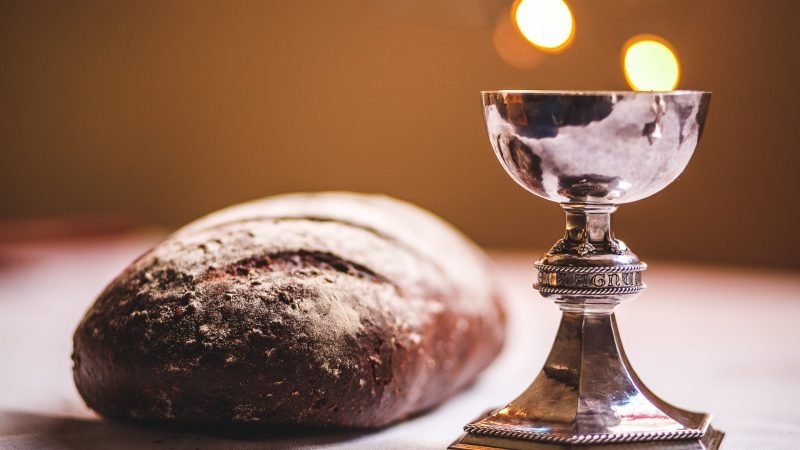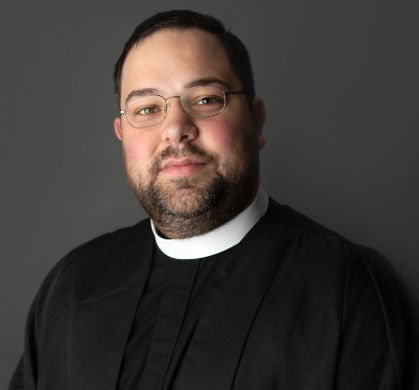Some have suggested that the historic Anglican practice of celebrating Holy Communion from the North Side (called the Right Side in some texts) of the Holy Table while using the 1928 American Book of Common Prayer is inappropriate and is out of conformity with the rubrics. This essay will repudiate that claim and demonstrate that the practice of celebrating Holy Communion from the North Side of the Holy Table is a venerable and beneficial practice, both for congregations and clergy.
Here follow the rubrics concerning the Holy Table and the placement of the minister of Holy Communion, which appear at the beginning of the service in the Book of Common Prayer in the 1662 English edition and the American 1789, 1892, and 1928 editions.
1662
The Table at the Communion time having a fair white linen cloth upon it, shall stand in the body of the Church, or in the Chancel, where Morning and Evening Prayer are appointed to be said. And the Priest standing at the north side of the Table shall say the Lord’s Prayer with the Collect following, the people kneeling.
1789 (before 1833)
The Table, at the Communion-time having a fair white linen cloth upon it, shall stand in the body of the Church, or in the Chancel. And the Minister, standing at the north side of the Table, or where Morning and Evening Prayer are appointed to be said, shall say the Lord’s Prayer with the Collect following, the people kneeling; but the Lord’s Prayer may be omitted, if Morning Prayer hath been said immediately before.
1789 (after 1833)
The Table, at the Communion-time having a fair white linen cloth upon it, shall stand in the body of the Church, or in the Chancel. And the Minister, standing at the right side of the Table, or where Morning and Evening Prayer are appointed to be said, shall say the Lord’s Prayer with the Collect following, the people kneeling; but the Lord’s Prayer may be omitted, if Morning Prayer hath been said immediately before.
(Historically, the word right in this context is a relative direction to the Holy Table and not a synonym for the word correct.)
1892
The Table, at the Communion-time having a fair white linen cloth upon it, shall stand in the body of the Church, or in the Chancel. And the Minister, standing at the right side of the Table, or where Morning and Evening Prayer are appointed to be said, shall say the Lord’s Prayer with the Collect following, the people kneeling; but the Lord’s Prayer may be omitted, if Morning Prayer hath been said immediately before.
1928
At the Communion-time the Holy Table shall have upon it a fair white linen cloth. And the Priest, standing reverently before the Holy Table shall say the Lord’s Prayer with the Collect following, the people kneeling; but the Lord’s Prayer may be omitted at the discretion of the Priest.
These rubrics demonstrate that the historically normative position of the minister of Holy Communion since the reformation in the Church of England is that of standing at the North, or Right, side of the Holy Table. The changes which appear in the 1928 BCP are not intended to abolish the North Side posture in favor of the Roman practice of celebrating ad orientem. Rather, unfortunately, the changes in the rubrical text are meant to create a flexibility that would permit Anglo-Catholic clergymen to exercise their Catholic theological perspective without failing to conform to the prayer book.
The argument has been made that the wording in the rubrical text that states that the priest should be “standing reverently before the Holy Table” can only be interpreted to mean “standing in front of the Holy Table”, implying the ad orientem posture. However, this argument does not hold up to scrutiny when put into the context of the rubrics, especially the rubric which appears immediately before the Prayer of Consecration.
1662
When the Priest, standing before the Table, hath so ordered the Bread and Wine, that he may with more readiness and decency break the bread before the people, and take the Cup into his hands, he shall say the Prayer of Consecration, as followeth.
1789
Then the Priest standing before the Table, hath so ordered the Bread and Wine, that he may with more readiness and decency break the bread before the People, and take the Cup into his hands, he shall say the Prayer of Consecration, as followeth.
1892
When the Priest, standing before the Table, hath so ordered the Bread and Wine, that he may with more readiness and decency break the bread before the People, and take the Cup into his hands, he shall say the Prayer of Consecration, as followeth.
1928
When the Priest, standing before the Holy Table, hath so ordered the Bread and Wine, that he may with more readiness and decency break the bread before the People, and take the Cup into his hands, he shall say the Prayer of Consecration, as followeth.
The lack of change in the rubric demonstrates that the wording “standing reverently before the Holy Table” is not incompatible with the North Side posture. Throughout the history of the older prayer books, the same or similar words were universally interpreted in such a way that the priest stood at the north side or end of the table. It was not until much later, near the end of the 19th and early 20th Centuries, that an argument was made for the implicit prohibition against the North Side posture.
In fact, the rubric further favors North Side posture over that of ad orientem by implying that the bread is to be readily and decently broken in the sight of the congregation and not hidden from view by the body of the minister, or worse still, clumsily held aloft above the minister’s head. Even less desirable is the practice of the minister turning around, away from the Holy Table, to break the bread so that the people can see it. This practice is neither decent nor favorable.
The rubrical requirement for “readiness and decency” suggests the desire for minimal movement and inconvenience on the part of the minister at the celebration. These words also implicitly encourage the minister to break bread over the plate in a graceful and reverent way.
Contrary to practice in many churches, the celebration of Holy Communion is neither intended to be, nor should be, a show or spectacle. The Lord’s Supper should not be put on display for an audience. Neither is it some distant mystical ritual to be secretly carried out behind closed doors, as is the custom of the East. Holy Communion is a sacred act that unites Christians who gather around the Lord’s table to receive the precious body and blood of our Lord Jesus Christ.



Over 50 years when I ago was seminarian at the Episcopal Seminary in Alexandria Virginia, our Homiletic’s professor celebrated Holy Communion wearing a Geneva gown and standing at the North end of the Holy Table. His hands were by his sides except when following the simple manual acts set forth in the BCP 1929. I still prefer a High Mass with Incense. However I still look back on my Low Church Seminary and the warmest of feelings. I was forced to discover and own the meaning and purpose of ritual and ceremony in Christian worship as well as the value… Read more »
Well, you seem to have forgotten WHY the priests stood on the north side to begin with. The priests originally faced liturgical East. Then, one of the many silly decrees came down to remove the altars and replace them with tables. Another silly decree came down that the tables were to be moved into the choir. However, they were too long and had to be turned sideways. Once that was done, the priest remained facing liturgical East with his back to the people, but now he was on the narrow end. Then, the decree came down to put the tables… Read more »
Could you please provide me with a source indicating the practice of celebrating Holy Communion facing east at the end of a nave-wise communion table? I have not come across that in my research, and it sounds rather interesting.